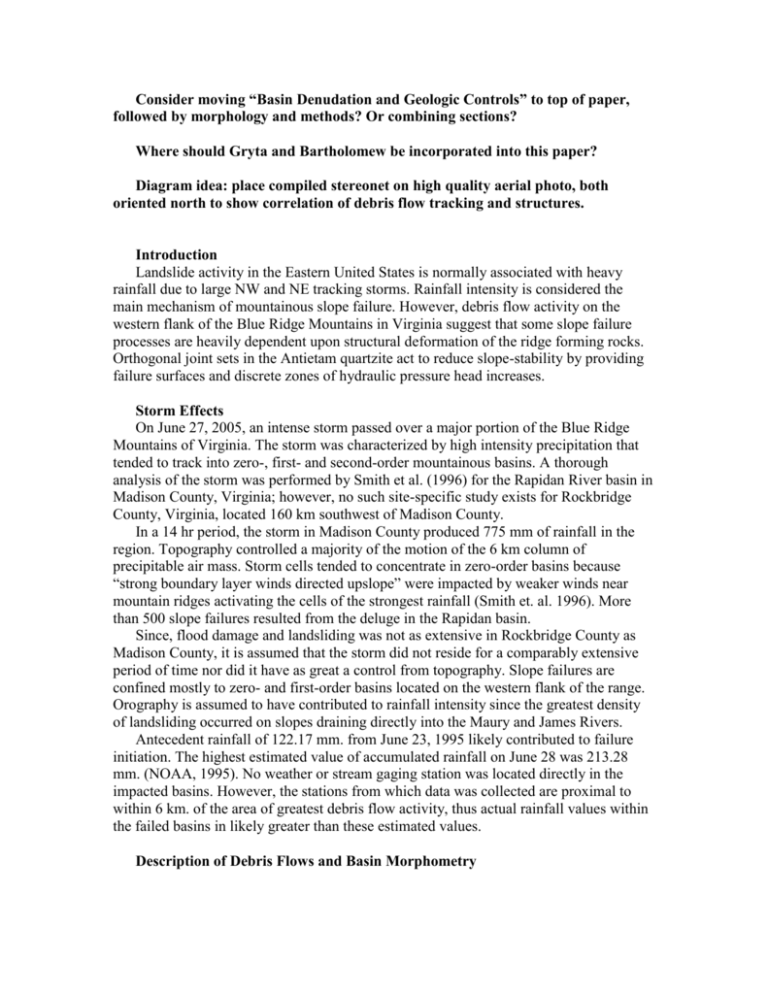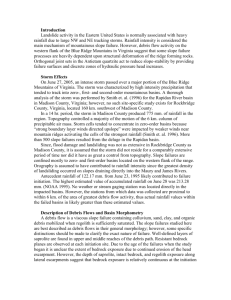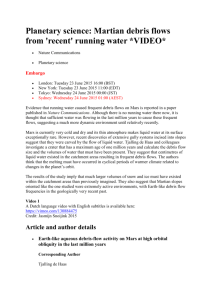Introduction
advertisement

Consider moving “Basin Denudation and Geologic Controls” to top of paper, followed by morphology and methods? Or combining sections? Where should Gryta and Bartholomew be incorporated into this paper? Diagram idea: place compiled stereonet on high quality aerial photo, both oriented north to show correlation of debris flow tracking and structures. Introduction Landslide activity in the Eastern United States is normally associated with heavy rainfall due to large NW and NE tracking storms. Rainfall intensity is considered the main mechanism of mountainous slope failure. However, debris flow activity on the western flank of the Blue Ridge Mountains in Virginia suggest that some slope failure processes are heavily dependent upon structural deformation of the ridge forming rocks. Orthogonal joint sets in the Antietam quartzite act to reduce slope-stability by providing failure surfaces and discrete zones of hydraulic pressure head increases. Storm Effects On June 27, 2005, an intense storm passed over a major portion of the Blue Ridge Mountains of Virginia. The storm was characterized by high intensity precipitation that tended to track into zero-, first- and second-order mountainous basins. A thorough analysis of the storm was performed by Smith et al. (1996) for the Rapidan River basin in Madison County, Virginia; however, no such site-specific study exists for Rockbridge County, Virginia, located 160 km southwest of Madison County. In a 14 hr period, the storm in Madison County produced 775 mm of rainfall in the region. Topography controlled a majority of the motion of the 6 km column of precipitable air mass. Storm cells tended to concentrate in zero-order basins because “strong boundary layer winds directed upslope” were impacted by weaker winds near mountain ridges activating the cells of the strongest rainfall (Smith et. al. 1996). More than 500 slope failures resulted from the deluge in the Rapidan basin. Since, flood damage and landsliding was not as extensive in Rockbridge County as Madison County, it is assumed that the storm did not reside for a comparably extensive period of time nor did it have as great a control from topography. Slope failures are confined mostly to zero- and first-order basins located on the western flank of the range. Orography is assumed to have contributed to rainfall intensity since the greatest density of landsliding occurred on slopes draining directly into the Maury and James Rivers. Antecedent rainfall of 122.17 mm. from June 23, 1995 likely contributed to failure initiation. The highest estimated value of accumulated rainfall on June 28 was 213.28 mm. (NOAA, 1995). No weather or stream gaging station was located directly in the impacted basins. However, the stations from which data was collected are proximal to within 6 km. of the area of greatest debris flow activity, thus actual rainfall values within the failed basins in likely greater than these estimated values. Description of Debris Flows and Basin Morphometry A debris flow is a viscous slope failure containing colluvium, sand, clay, and organic debris mobilized when regolith is sufficiently saturated. The slope failures studied here are best described as debris flows in their general morphology; however, some specific distinctions should be made to clarify the exact nature of failure. Well-defined layers of saprolite are found in upper and middle reaches of the debris path. Resistant bedrock planes are observed at each initiation site. Due to the age of the failures when the study began it is unclear the extent of bedrock exposure due to continued erosion of the head escarpment. However, the depth of saprolite, intact bedrock, and regolith exposure along lateral escarpments suggest that bedrock exposure is relatively continuous at the initiation sites. As the initial debris slide continues downslope bedrock exposure becomes increasingly discontinuous. The bedrock exposed at the failure apices have similar sedimentary structures including the fossil Skolithus linearis and grain size was observed to be consistent. It is likely that this is a stratigraphically-continuous unit based on the depth of saprolite developed on top of the resistant failure surface. The high density of Skolithus in the resistant layer and lack in the saprolite suggests that the trace fossils provide a greater rheologic strength and the tightly spaced sediments within the wormholes decreases pore space and infiltration capacity. Methods Denudation volumes were calculated by reconstructing the pre-erosional slopes adjacent to the debris flow path and measuring a cross-sectional area as described by Shroyer (1997). Cross-sectional depths were measured from a string line spanning across the width of the failure and measuring to the eroded surface at width intervals of 1 m. Measurement of the debris flow in Bennetts Run included 16 cross-sections at intervals of 60 m through the thalweg. The smaller flow located on Poplar Cove required a total of 6 cross-sections at 30 m intervals through the thalweg. The volume of material removed is calculated by averaging each value of depth with the previous value of depth measured across the width of the failure. These averages are then summed and multiplied by the distance between each cross-section. The sum of these values yields the total volume of material removed by denudation. Basin denudation is then calculated by dividing the total volume by the area of the basin. A planimeter was used to measure the basin area on 7.5 minute U. S. Geological Survey topographic quadrangles. The extent of basin area was precisely located using aerial photo and field reconnaissance. The orientation of joints and bedding planes were measured using a Brunton compass. Selection of planes measured depended upon available outcrop within the debris flow. On the outcrop planes were selected systematically based upon the geometric relationship between the thalweg, relatively unweathered surfaces, and the aspect of failure. Bedding planes were differentiated from joint surfaces using primary sedimentary structures such as cross-bedding and Skolithus linearis. Orthogonal jointing was observed in outcrop and in colluvial deposits so there was no necessity to establish this geometry using stereonet analysis. The Fisher test was used to determine the statistical correlation between the joint data. The steronet analysis program StereoWin v. 1.2 includes a Fisher test so its validity and accuracy were confirmed in personal communication with the program developer (Allmendinger, 2006). The Fisher test utilizes the von Mises distribution for spherical data to determine the significance (within a 95 percent confidence interval) of variance within the sample (Davis, 2002). Essentially, if the initial test for variance results in a critically high value of R/n, then there is more than one subset of data within the total sample. The critical value of R/n is based on the sample size which can yield a misleading resultant if the total dataset is truly bimodal. Thus, a post hoc test of variance is then performed on each sample to determine the statistical significance of each subset to alleviate any misleading results of the initial test for variance. Subset selection depended upon 3-dimensional contouring of the data and visual estimation to include or exclude poles within subset. The 3-dimensional contours represent the calculation of a concentration parameter, k. Basin Denudation and Geologic Controls A comparison of basin denudation values reported for 12 basins in Virginia and West Virginia showed that the two basins measured in this study have significantly higher values. The previously greatest value reported for a clastic basin in West Virginia was 2.15 * 10-3 m (Cenderelli and Kite, 1998). The highest value measured in this study was 1.30 * 10-1 m. Patterns of erosion and deposition are similar for both of these regions (Cenderelli and Kite, 1994). In the upper two-thirds of the debris flow track erosion is dominant, and in the lower third deposition is dominant. Cenderelli and Kite (1994) describe four zones within impacted basins: “an upper failure zone, a middle transport zone, a lower deposition zone, and a scour zone immediately beyond the debris-flow terminus.” Additionally, they described the presence of hyperconcentrated flow deposits in stream channels. Stream channels in Rockbridge County show similar deposits from ancient activity. Well-weathered, poorly to moderately imbricated cobbles are supported in a red, clay rich sediment matrix. Hyperconcentrated stream deposits are likely to have existed in this region directly following recent activity, however, their record was not preserved within the ten years between activity and the time of this work. Sediment yields in West Virginia range from 3300 m3 to 20900 m3. Basin areas range from 1.78 km2 to 17.48 km2. Comparable sediment yields of 2447 m3 and 25185 m3 measured in Rockbridge County. However, basin areas are 0.28 km2 and 1.94 km2. These relatively small basin areas may provide a mathematical explanation for such high calculated values of basin denudation where sediment yields are comparable. However, mathematics aside, there remain implications for a geologic process which may control erosion allowing for greater basin denudation. Structural control on failure mechanisms and on lateral and vertical erosion is a likely explanation for the phenomenon. Outcroppings of quartzite at the failure apex, through the thalweg and on lateral escarpments observed in the upper two thirds of the debris flow track suggest structural control on failure initiation and erosion. Planar bedrock features located at the failure apices suggest these debris flows initiate as debris slides. Such bedrock planes were observed in all 9 of the longer debris flows. Sedimentary structures including cross-bedding and trace fossils where used to infer bedding planes. Similar sedimentary structures and plane orientations are exposed lower in the debris flow track. The resultant vector of pole to plane orientations (R/n = .98) indicates a high correlation between the measurements of these bedding planes. The value of n = 11 appears to violate an essential assumption of most statistical tests which require a value of n = 30 for the null hypothesis to be worthy of testing. However, the effect on error propagation of low n-values in Fisher statistics appears to be small (Whitney and Merrill, 1974). The units acting as slide planes are not likely to be stratigraphically correlated based on differing grain sizes, packing, and abundance of trace fossils. However, each plane contained some amount of Skolithus fossils. Observations of sedimentary packing and density of fossil occurrence in failure planes and lack thereof observed in overlying units suggests a correlation between sedimentology, weathering, and decoupling of resistant and non-resistant units. Beds overlying the failure plane are saprolitic and are only poorly preserved on lateral escarpments adjacent to initiation sites. The fissile nature of the contact between the slide plane and failure unit is due to the relative resistance and nonresistance to weathering of the units. Saprolite exposure and colluvial covering on failure planes are attributed to the backstepping of the failure apex due to long-term weathering processes including frost action and rainwater erosion. Joint planes are the dominant control on lateral erosion within the upper two thirds of the debris flow track. Two distinct populations of joints, one coinciding with the southeast escarpment, the other with the northeast escarpment, were calculated using the Fisher test. For the southwest escarpment R/n = .42 and k = 1.7 and for the northeast escarpment R/n = .81 and k = 5.4. The sample size for the northeast escarpment is stronger than for the southwest escarpment due to the availability of measurable data in the field. Although the southwest escarpment sample fails the Fisher test where the critical value of R/n = .50, the stereonet still makes a visually compelling argument for the relationship amongst the data. A stronger dataset would most likely improve the statistical resultant for this escarpment. The correlation and concentration of the data for the northeast escarpment is strong with R/n well above the critical value of .30. Figure # shows a compiled stereonet of each pole-to-plane joint population and the pole-to-plane bedding population with the average azimuth of debris flow track direction. The failure direction is roughly parallel to the dip direction and along azimuth with the bedding plane population. The failure direction also falls between each of the joint populations and is roughly coincident with the trend and plunge of the two joint sets. In general, the statistical correlation within each pole-to-plane population combined with the stereographic relationship with the mean failure azimuth strongly suggests structural control of the debris flow track. Furthermore, these structural controls are likely facilitating the high basin denudations measured in this region. Gryta and Bartholomew (1989) found that penetrative rock fabrics such as foliation and compositional layering are associated with chute azimuths of debris avalanches in Nelson County, VA. Nearly 2 percent of chute azimuths following a preferred orientation of failure did not correlate with penetrative rock fabrics. Although jointing was not studied, the 2 percent could be attributed to such non-penetrative structures. The highest values of precipitation from isoheytal data, in this region, showed a high correlation to preferred chute azimuth and thus was the primary factor influencing preferential failure azimuths. However, the high correlation of chute azimuth along dip direction of rock fabrics strongly suggests a secondary control of bedrock structures. Fisher statistics applied in their work use nearly identical operations as those that we used.








